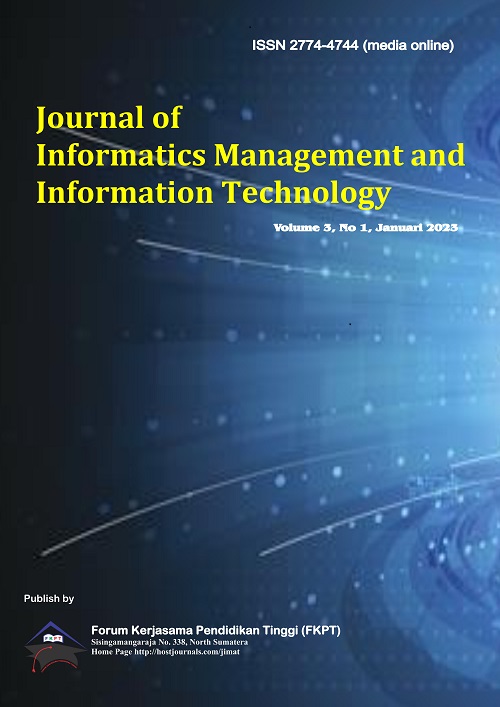Penerapan Metode Multi-Objective Optimization on the Basis of Ratio Analysis (MOORA) dalam Seleksi Penerimaan Peserta Kegiatan Program Pendidikan Kecakapan Wirausaha
DOI:
https://doi.org/10.47065/jimat.v3i1.238Keywords:
Selection; Training; Entrepreneurial Skills Education Program; DSS; MOORA MethodAbstract
The Entrepreneurial Skills Education Program (PKW), is one of the programs from the Ministry of Education and Culture in 2019. PKW is an educational service through courses and training to provide knowledge, skills, and foster an entrepreneurial mental attitude in managing self-potential and the environment as a basis for entrepreneurship. This study aims to select the acceptance of participants in the Entrepreneurial Skills Education (PKW) program. The method used in the selection is by applying the MOORA method. The MOORA method is a method with very simple steps. The results showed that A1 is the best compared to several other alternatives with a value of 0.304
Downloads
References
T. Limbong et al., Sistem Pendukung Keputusan: Metode & Implementasi. Medan: Yayasan Kita Menulis, 2020.
D. Nofriansyah and S. Defit, Multi Criteria Decision Making (MCDM) pada Sistem Pendukung Keputusan. 2018.
S. Sundari, Karmila, M. N. Fadli, D. Hartama, A. P. Windarto, and A. Wanto, “Decision Support System on Selection of Lecturer Research Grant Proposals using Preferences Selection Index,” J. Phys. Conf. Ser., vol. 1255, no. 1, 2019.
Y. J. B. Parrangan et al., “The Implementation of VIKOR Method to Improve the Effectiveness of Sidi Learning Graduation,” Int. J. Eng. Technol., 2018.
Jasri, D. Siregar, and R. Rahim, “Decision Support System Best Employee Assessments with Technique for Order of Preference by Similarity to Ideal Solution,” Int. J. Recent TRENDS Eng. Res., vol. 3, no. 3, pp. 6–17, 2017.
D. Nofriansyah, Konsep Data Mining Vs Sistem Pendukung Keputusan. 2015.
Efraim Turban and Jay E. Aronson, Decision Support System and Intelligent Systems. 2001.
D. Nofriansyah, Multi Criteria Decision Making (MCDM) Pada Sistem Pendukung Keputusan. Yogyakarta: CV.Budi Utama, 2017.
J. Hutagalung, K. Erwansyah, F. Sonata, and B. Anwar, “Baker Terbaik Combination of Ahp and Moora Methods in Choosing,” vol. 7, no. 2, 2022.
N. K. Daulay, B. Intan, and M. Irvai, “Comparison of the WASPAS and MOORA Methods in Providing Single Tuition Scholarships,” IJICS (International J. Informatics Comput. Sci., vol. 5, no. 1, pp. 84–94, 2021.
A. T. Hidayat, N. K. Daulay, and Mesran, “Penerapan Metode Multi-Objective Optimization on The Basis of Ratio Analysis (MOORA) dalam Pemilihan Wiraniaga Terbaik,” J. Comput. Syst. Informatics, vol. 1, no. 4, pp. 367–372, 2020.
S. W. Sari and B. Purba, “Sistem Pendukung Keputusan Pemilihan Ketua Danru Terbaik Menggunakan Metode ARAS,” Semin. Nas. Teknol. Komput. Sains SAINTEKS 2019, pp. 291–300, 2019.
R. T. Aldisa, A. Priyatna, F. Saidah, K. Y. Siahaan, and Mesran, “Analisis Perbandingan Penerapan Metode MOORA dan SAW dalam,” J. Sist. Komput. dan Inform., vol. 3, no. 4, pp. 393–404, 2022.
D. Assrani, N. Huda, R. Sidabutar, I. Saputra, and O. K. Sulaiman, “Penentuan Penerima Bantuan Siswa Miskin Menerapkan Metode Multi Objective Optimization on The Basis of Ratio Analysis (MOORA),” Penentuan Penerima Bantu. Siswa Miskin Menerapkan Metod. Multi Object. Optim. Basis Ratio Anal., vol. 5, no. 2407–389X (Media Cetak), pp. 1–5, 2018.
Bila bermanfaat silahkan share artikel ini
Berikan Komentar Anda terhadap artikel Penerapan Metode Multi-Objective Optimization on the Basis of Ratio Analysis (MOORA) dalam Seleksi Penerimaan Peserta Kegiatan Program Pendidikan Kecakapan Wirausaha
ARTICLE HISTORY
Issue
Section
Copyright (c) 2023 Fazlur Rahman, Abdi Harfani, Mesran, Kelik Sussolaikah, Nelly Khairani Daulay, Ronal Watrianthos

This work is licensed under a Creative Commons Attribution 4.0 International License.
Authors who publish with this journal agree to the following terms:
- Authors retain copyright and grant the journal right of first publication with the work simultaneously licensed under Creative Commons Attribution 4.0 International License that allows others to share the work with an acknowledgment of the work's authorship and initial publication in this journal.
- Authors are able to enter into separate, additional contractual arrangements for the non-exclusive distribution of the journal's published version of the work (e.g., post it to an institutional repository or publish it in a book), with an acknowledgment of its initial publication in this journal.
- Authors are permitted and encouraged to post their work online (e.g., in institutional repositories or on their website) prior to and during the submission process, as it can lead to productive exchanges, as well as earlier and greater citation of published work (Refer to The Effect of Open Access).















